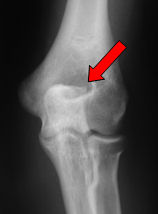Posterior Impingement of Elbow
Cause:
Posterior impingement is due to over use and repetitive forced extensions of the elbow. This may occur during sports, such as overhead racket sports, throwing, swimming and boxing. With repeated extension (straightening of the elbow), the olecranon tip is repeatedly jammed into the fossa at the back of the elbow, which results in inflammation of the joint lining (synovium), proceeding to injury to the cartilage and bone. Bone spurs may sometimes form on the tip of the olecranon leading to further injury and soft tissue impingement. There becomes increased risks of impaction and injury when there are shearing forces that occur as at result of a valgus strain (strain that opens up the inner side of the elbow), such as during serving and hitting topspin forehands with an extreme wrist and grip in tennis; similarly, this may occur with badminton.
Symptoms:
The typical symptoms are pain and tenderness at the back of the elbow, especially when trying to throw, straighten the elbow, or during serving and overhead racket shots. This may proceed to locking and a catching of the elbow. There may be swelling of the elbow and inability to serve at full speed. There may be some elbow stiffness and towards the late stages an inability to fully straighten the elbow.
Investigations:
Investigations such as x-rays may not adequately reveal the diagnosis unless there are spurs or loose bodies in the back of the elbow. Ultrasound scan and MRI scan may be useful in expert hands.

Posterolateral spur inidicative of posterior impingement of the elbow in a young tennis player
Treatment:
Posterior impingement syndrome of the elbow is often treatable with non-operative management. A rehabilitation programme to improve strength, flexibility and elbow range of motion may be helpful. Injections into the posterior compartment (back) of the elbow are often useful to reduce the inflammation and swelling, either Cortico- steroids or Hyaluronons may be used. When non-operative measures have failed or particularly if there is locking and catching due to loose bone fragments within the joint and spurs, arthroscopic (keyhole) surgery is required to remove them. Return to sports after this surgery may take up to 3 months.


